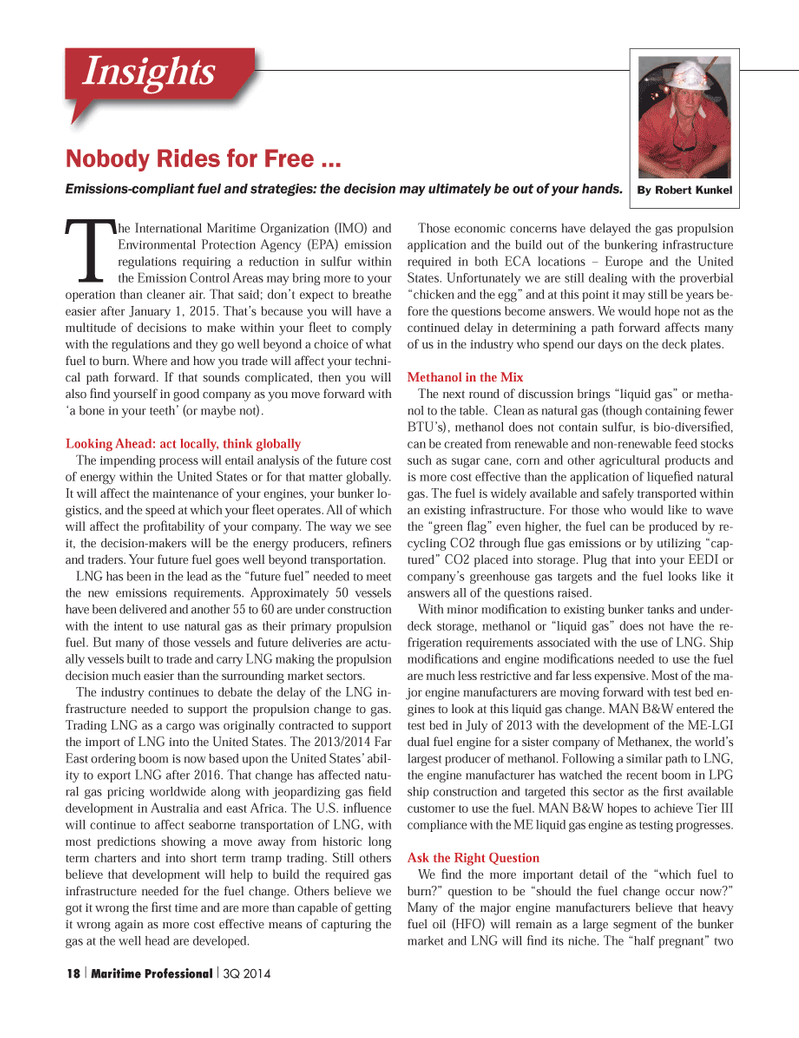
Page 18: of Maritime Logistics Professional Magazine (Q3 2014)
Power & Fuel Management
Read this page in Pdf, Flash or Html5 edition of Q3 2014 Maritime Logistics Professional Magazine
Nobody Rides for Free ? Emissions-compliant fuel and strategies: the decision may ultimately be out of your hands. InsightsThe International Maritime Organization (IMO) and Environmental Protection Agency (EPA) emission regulations requiring a reduction in sulfur within the Emission Control Areas may bring more to your operation than cleaner air. That said; don?t expect to breathe easier after January 1, 2015. That?s because you will have a multitude of decisions to make within your eet to comply with the regulations and they go well beyond a choice of what fuel to burn. Where and how you trade will affect your techni- cal path forward. If that sounds complicated, then you will also nd yourself in good company as you move forward with ?a bone in your teeth? (or maybe not). Looking Ahead: act locally, think globally The impending process will entail analysis of the future cost of energy within the United States or for that matter globally. It will affect the maintenance of your engines, your bunker lo- gistics, and the speed at which your eet operates. All of which will affect the pro tability of your company. The way we see it, the decision-makers will be the energy producers, re ners and traders. Your future fuel goes well beyond transportation. LNG has been in the lead as the ?future fuel? needed to meet the new emissions requirements. Approximately 50 vessels have been delivered and another 55 to 60 are under construction with the intent to use natural gas as their primary propulsion fuel. But many of those vessels and future deliveries are actu- ally vessels built to trade and carry LNG making the propulsion decision much easier than the surrounding market sectors. The industry continues to debate the delay of the LNG in-frastructure needed to support the propulsion change to gas. Trading LNG as a cargo was originally contracted to support the import of LNG into the United States. The 2013/2014 Far East ordering boom is now based upon the United States? abil- ity to export LNG after 2016. That change has affected natu- ral gas pricing worldwide along with jeopardizing gas eld development in Australia and east Africa. The U.S. in uence will continue to affect seaborne transportation of LNG, with most predictions showing a move away from historic long term charters and into short term tramp trading. Still others believe that development will help to build the required gas infrastructure needed for the fuel change. Others believe we got it wrong the rst time and are more than capable of getting it wrong again as more cost effective means of capturing the gas at the well head are developed. Those economic concerns have delayed the gas propulsion application and the build out of the bunkering infrastructure required in both ECA locations ? Europe and the United States. Unfortunately we are still dealing with the proverbial ?chicken and the egg? and at this point it may still be years be- fore the questions become answers. We would hope not as the continued delay in determining a path forward affects many of us in the industry who spend our days on the deck plates.Methanol in the MixThe next round of discussion brings ?liquid gas? or metha- nol to the table. Clean as natural gas (though containing fewer BTU?s), methanol does not contain sulfur, is bio-diversi ed, can be created from renewable and non-renewable feed stocks such as sugar cane, corn and other agricultural products and is more cost effective than the application of lique ed natural gas. The fuel is widely available and safely transported within an existing infrastructure. For those who would like to wave the ?green ag? even higher, the fuel can be produced by re- cycling CO2 through ue gas emissions or by utilizing ?cap- tured? CO2 placed into storage. Plug that into your EEDI or company?s greenhouse gas targets and the fuel looks like it answers all of the questions raised.With minor modi cation to existing bunker tanks and under- deck storage, methanol or ?liquid gas? does not have the re- frigeration requirements associated with the use of LNG. Ship modi cations and engine modi cations needed to use the fuel are much less restrictive and far less expensive. Most of the ma- jor engine manufacturers are moving forward with test bed en- gines to look at this liquid gas change. MAN B&W entered the test bed in July of 2013 with the development of the ME-LGI dual fuel engine for a sister company of Methanex, the world?s largest producer of methanol. Following a similar path to LNG, the engine manufacturer has watched the recent boom in LPG ship construction and targeted this sector as the rst available customer to use the fuel. MAN B&W hopes to achieve Tier III compliance with the ME liquid gas engine as testing progresses. Ask the Right QuestionWe nd the more important detail of the ?which fuel to burn?? question to be ?should the fuel change occur now?? Many of the major engine manufacturers believe that heavy fuel oil (HFO) will remain as a large segment of the bunker market and LNG will nd its niche. The ?half pregnant? two By Robert Kunkel18 | Maritime Professional | 3Q 201418-33 Q3 MP2014.indd 1818-33 Q3 MP2014.indd 188/13/2014 3:32:24 PM8/13/2014 3:32:24 PM

 17
17

 19
19
